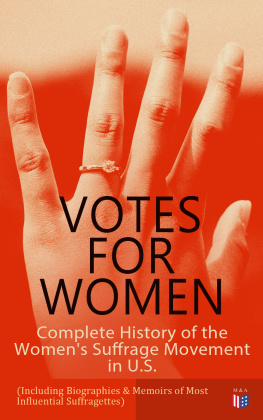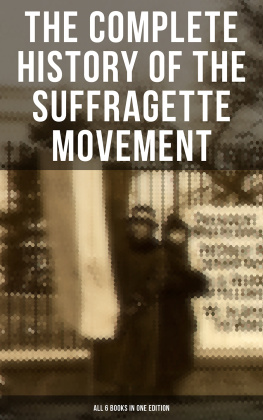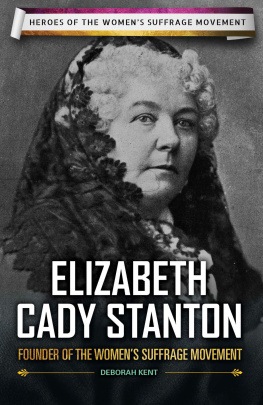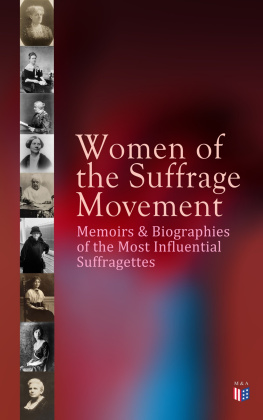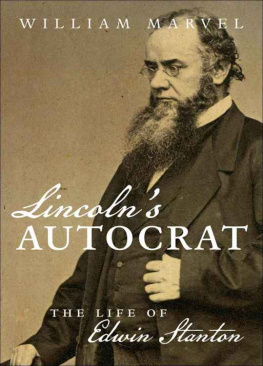In Her Own Right
IN HER OWN RIGHT
The Life of Elizabeth Cady Stanton
ELISABETH GRIFFITH

Oxford University Press
Oxford New York Toronto
Delhi Bombay Calcutta Madras Karachi
Petaling Jaya Singapore Hong Kong Tokyo
Nairobi Dar es Salaam Cape Town
Melbourne Auckland
and associated companies in
Beirut Berlin Ibadan Mexico City Nicosia
Copyright 1984 by Elisabeth Griffith
First published in 1984 by Oxford University Press, Inc.,
198 Madison Avenue, New York, New York 10016-4314
First issued as an Oxford University Press paperback, 1985
Oxford is the registered trademark of Oxford University Press.
All rights reserved. No part of this publication may be reproduced,
stored in a retrieval system, or transmitted, in any form or by any means,
electronic, mechanical, photocopying, recording, or otherwise,
without the prior permission of Oxford University Press, Inc.
Library of Congress Cataloging in Publication Data
Griffith, Elisabeth.
Includes index.
1. Stanton, Elizabeth Cady, 18151902.
2. FeministsUnited StatesBiography.
3. SuffragettesUnited StatesBiography.
4. Womens rightsUnited StatesHistory. I. Title.
HQ1413.S67G74 1984 324.6230924 [B] 83-25120
ISBN 978-0-19-503729-6
For my mother
Acknowledgments
Like detectives, historians search for clues, follow leads, examine documents, evaluate evidence, and investigate lives. The case of Elizabeth Cady Stanton sent me across the country in pursuit of correspondence by or about her and in search of lost relatives. I always expected to find a cache of hidden letters in some great-grandchilds attic, but I never did. Instead I discovered the generosity of librarians and scholars and the excitement of getting the facts.
At the libraries and historical societies I visited, I was assisted by knowledgeable, courteous professionals. For their assistance and enthusiasm, I would like to thank the staffs at the Susan B. Anthony Memorial, Rochester, New York; the Boston Public Library, Department of Rare Books and Manuscripts; the Buffalo and Erie County Public Library; the Mabel Smith Douglass Library, Rutgers University; the Geneva (New York) Historical Society and Museum; the Houghton Library, Harvard University; the Huntington Library, San Marino, California; the Johnstown (New York) Public Library; the Library of Congress; the Missouri Historical Society, St. Louis; the New-York Historical Society; the New York Public Library; the Arthur and Elizabeth Schlesinger Library, Radcliffe College; the Seneca Falls (New York) Historical Society; the Sophia Smith Collection, Smith College; the Elizabeth Cady Stanton Foundation, Seneca Falls, New York; the Ernest Bird Library, Syracuse University; and Vassar College.
Equally helpful were the many people who answered my written requests, directed to the Columbia University Archives, New York; the Cornell University Archives and Alumni Office, Ithaca; the Friends Historical Society, Swarthmore College, Haverford, Pennsylvania; the Historical Society of Pennsylvania, Philadelphia; the Madison County (New York) Historical Society; the Minnesota Historical Society, St. Paul; the Stowe-Day Memorial Library and Historical Society, Hartford; the Clements Library at the University of Michigan, Ann Arbor; and the Yale University Alumni Records Office, New Haven. Individuals like Kenneth L. Brock, Archivist for the Emma Willard School; Virginia Mosley, Borough Historian of Tenafly, New Jersey; Charles Noxon of the Johnstown Historical Society; and Wilfred Rauber, Town and Village Historian of Dansville, New York, were both thorough and thoughtful in their responses. I especially want to thank my sister, Jane Griffith Bryan, head of the reference department of the Van Pelt Library at the University of Pennsylvania, who was never too busy to respond to my long-distance demands.
Unfortunately, too many of the people who helped me were never identified or introduced, like the woman at the public library in Greenwich, Connecticut, who answered my telephone query about the children of Stantons granddaughter, whom the New York Times obituary reported to have died in Greenwich. She directed me to Stantons great-granddaughter, Rhoda Barney Jenkins. She lives just down the block, said the voice on the phone. When I called Mrs. Jenkins, she invited me and my tape recorder to spend the afternoon. That encounter began a friendship with a woman who resembles her famous foremother in many ways and who contributed her family memories and photographs to this book.
Another chance clue prompted an inquiry to the public librarian in Beaman, Iowa, who forwarded my letter to Barbara Wood McMartin, great-granddaughter-in-law of Stantons sister Margaret. Mrs. McMartin, an energetic genealogist, helped trace the offspring of the rest of the Cady sisters. Also helpful were the court clerks in the County of New York (City) and Fulton County, New York.
The steadfast encouragement of my dissertation committee at American University invigorated this project. Their combined confidence in me and their demands on me strengthened this biography and honed my skills as a historian. Robert L. Beisner, the chairman of the committee, kept me on course and on schedule with good-humored patience; his skill as an editor challenged me to meet his standard of excellence. If Dr. Beisner was my mentor, Professor Valerie French was my role model. Her commitment to historical applications of psychological methodology convinced me to attempt a psychobiography of Stanton, and her informed questions forced me to probe more deeply and widely than I might have on my own. Alan Kraut contributed his expertise on abolition and nineteenth-century reform movements. Kay Mussell, head of the American Studies department, corrected my interpretations of womens history and sought to improve my craftsmanship as a writer.
This biography also benefited from the critical reading of John M. Cooper, Jr., of the University of Wisconsin, Madison, who had been my undergraduate adviser at Wellesley College; Anne Macdonald, head of the history faculty at the National Cathedral School in Washington, who nurtured both the book and its author; and Mary Grant, whose dissertation on Julia Ward Howe, an enemy of Stantons, cemented our friendship. These friends deserve special thanks, as do the scholars who shared their insights or research with me: Margaret Hope Bacon, Ellen C. DuBois, Corinne Guntzel, Blanche Glassman Hersch, Kirk Jeffrey, Mary Kelley, Hanns Kuttner, Allan J. Lichtman, Edith Mayo, Carol Weissbrod, Judith Wellman, and Kathy Widom.
A Woodrow Wilson Grant for Research in Womens Studies, awarded in 1978, provided me with funds for travel and the purchase of The History of Woman Suffrage, as well as for photocopying and day care, all of which were necessary to the completion of this project.
I am even more indebted to Audrey Wolf, my agent, to Sheldon Meyer, my editor, to Ann Hofstra Grogg, my copy editor, and to Joan Fraser and Julia Goetz, friends and assistants, for sharing my enthusiasm for Mrs. Stanton. Finally, I want to thank my family for their encouragement and endurance: Anne and Katie, who almost completed their degrees before I did; my daughter Megan, whose joyful presence cheered me; and especially my husband, John Deardourff, who sustained me. All of us came to think of Mrs. Stanton as a member of our extended household.
|
McLean, Virginia
December 1983 | Elisabeth Griffith |
Next page


